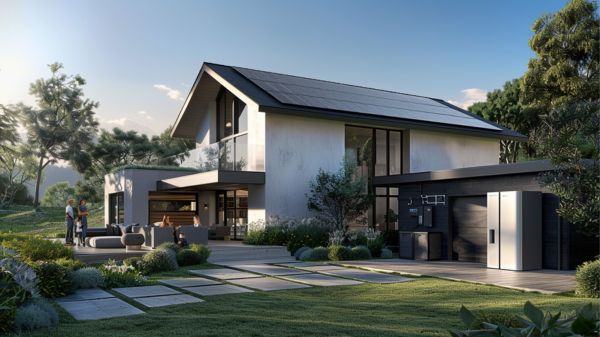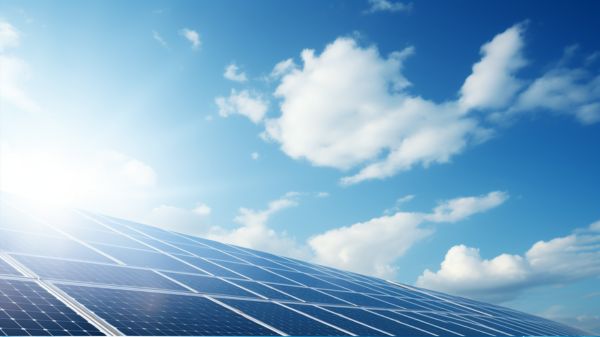Installing a solar system is an intricate process that begins with a thorough evaluation of your home’s energy requirements and exploring available financial incentives. Selecting a credible installer is essential, as they will design a system tailored to your specific site characteristics and energy needs.
The legal landscape also plays a significant role, requiring careful management of permits and documentation. The physical installation includes setting up a racking system, mounting the panels, and integrating inverters. But what happens after the panels are in place? How do inspections, grid connections, and ongoing maintenance influence the system’s efficacy and durability?
Key Takeaways
- Assess home energy needs and roof suitability for optimal panel placement.
- Evaluate financial incentives and select a certified solar installer.
- Design the solar system to meet specific energy requirements.
- Manage necessary permits and documentation for compliance and installation.
- Install the solar panels and connect the system to the power grid.
Assessing Home Energy Needs
Evaluating your home’s energy needs is a critical first step in the installation of a solar system. Start by analyzing your electric bill to gauge monthly energy usage and determine peak consumption periods. This analysis provides insight into your typical energy demands, guiding the scale and specifications of the potential solar installation.
Next, conducting a home energy audit is vital. This audit identifies inefficiencies in your current energy usage, offering opportunities for improvements that can reduce the overall energy requirement. By optimizing energy use, you can often reduce the size and cost of the solar system needed.
Assessing the characteristics of your roof is also paramount. Factors such as shading, orientation, and tilt affect the solar system’s performance and energy production capabilities. An appropriately sized system, taking into account these factors, guarantees maximum efficiency and output.
Additionally, consider the types of solar panels available, as choosing the right type can greatly influence efficiency.
Furthermore, utilize solar potential calculators available online. These tools estimate the energy production possible from solar panels installed on your roof, based on its specific characteristics and your geographic location.
Evaluating Financial Incentives
Understanding the range of financial incentives available is vital when evaluating the installation of a solar system. Assessing financial incentives can greatly influence the affordability and feasibility of solar installations. Here are key points to take into account:
- Federal Investment Tax Credit (ITC): This incentive allows homeowners to deduct 30% of the cost of installing a solar system from their federal taxes, providing substantial savings on the initial investment.
- State and Local Incentives: Many states and local governments offer additional rebates and grants which can further reduce costs. These incentives vary widely, so it’s important to research what’s available in your specific location.
- Financing Options: Homeowners have various financing options to choose from, including solar loans, leases, and power purchase agreements (PPAs). These financial structures can help manage the upfront costs, making solar technology more accessible.
- Consultation with Energy Advisors: Engaging with professional Energy Advisors can help navigate the complex landscape of incentives and rebates. They provide tailored advice to maximize potential savings and guarantee that all applicable benefits are leveraged effectively.
Additionally, exploring utility programs that offer incentives for renewable energy adoption can provide further financial benefits and support the integration of solar systems into existing infrastructures.
Selecting a Solar Installer
When selecting a solar installer, it’s vital to compare quotes from multiple providers to guarantee competitive pricing and ideal service tailored to your specific needs.
Verification of each installer’s credentials, including licensing and insurance, is essential for protecting your investment.
Additionally, evaluating the installer’s experience through customer reviews and project history can provide insights into their capability and reliability in delivering quality solar solutions.
It’s also important to check if the installer has relevant certifications, such as those from NABCEP, which indicate a higher standard of professionalism and knowledge in solar technology.
Compare Installer Quotes
To guarantee you receive the best value for your investment in solar technology, it is vital to compare multiple quotes from reputable solar installers. Engaging with various solar companies and requesting multiple estimates allows for a thorough perspective on competitive pricing and options available.
This guarantees not only cost-effectiveness but also compatibility with your specific energy needs and home layout.
Here are pivotal factors to reflect on when comparing installer quotes:
- Total System Costs: Evaluate the complete financial outlay, including the cost of installation, equipment, and any financing options. This helps in understanding the upfront investment versus the long-term energy savings.
- Equipment and Workmanship Warranties: Choose installers who provide robust warranties. This reflects their confidence in their offerings and protects you against future issues.
- Customer Reviews and Ratings: Research each installer’s track record through verified customer reviews to gauge their reliability and the quality of communication.
- Use of Online Marketplaces: Platforms like EnergySage can be invaluable for comparing quotes from pre-vetted providers, enriched with user feedback and detailed profiles.
Verify Installer Credentials
After comparing installer quotes, it is essential to verify the credentials of your chosen solar installer to guarantee they meet the industry standards and deliver high-quality service.
The first step in this process is to confirm the installer has the appropriate licensing and insurance, as mandated by most states. This safeguard protects homeowners throughout the installation process of solar panels.
Additionally, certifications like those from the North American Board of Certified Energy Practitioners (NABCEP) are significant indicators of an installer’s expertise and commitment to quality in the solar industry. Such credentials suggest a proficiency that aligns with the highest industry standards.
It is also important to explore customer reviews on platforms such as EnergySage or the Better Business Bureau (BBB). These reviews can provide insight into the installer’s reliability and quality of service, directly from previous customers’ experiences.
Lastly, confirm that the installer is well-versed with local codes and regulations. This knowledge is essential not only for guaranteeing safety and compliance but also for a smooth permitting process.
Familiarity with these regulations impacts the overall success and legality of your solar installation project.
Assess Installer Experience
Evaluating the experience of a solar installer is crucial in selecting a competent professional for your solar system project. An experienced solar installer not only guarantees a high-quality installation but also navigates the complexities of local regulations and incentives effectively.
Here are key factors to take into account:
- Certifications: Look for certifications from entities like the North American Board of Certified Energy Practitioners (NABCEP). This indicates that the installer maintains a standard of knowledge and competence recognized across the industry.
- Successful Installations: Investigate the number of successful installations the installer has completed. A robust portfolio of several dozen projects demonstrates significant hands-on experience and technical proficiency.
- Customer References and Reviews: Request customer references and read online reviews to assess the quality of service and customer satisfaction. This feedback reflects the installer’s ability to meet client expectations and address any concerns post-installation.
- Knowledge of Local Regulations and Incentives: Confirm that the installer has up-to-date knowledge of local permitting processes and available incentives. This expertise can facilitate a smoother installation process and optimize financial benefits.
Selecting an installer with a proven track record, relevant certifications, positive customer feedback, and thorough warranties guarantees a superior installation experience and long-term satisfaction.
| # | Preview | Product | Rating | Price | |
|---|---|---|---|---|---|
| 1 |

|
ECO-WORTHY Complete Off-Grid Solar Kit:5000W 120V/48VDC Solar Off-Grid Inverter+10.24kWh... | $6,599.99 | Buy on Amazon | |
| 2 |

|
ECO-WORTHY 10KW Output 9.36KWH Off Grid Solar System Complete Kit for Home:12pcs 195W Solar... | $5,299.99 | Buy on Amazon |
Designing the Solar System
In designing a solar system, determining the correct system size is essential and begins with a thorough assessment of the energy needs based on various consumption patterns.
After this phase, a meticulous site survey evaluates factors like roof shading, orientation, and tilt to enhance the system’s performance and efficiency.
The design process integrates customer feedback and visual representations to refine and finalize the layout, ensuring both ideal energy production and client satisfaction.
System Size Determination
How can homeowners accurately determine the size of the solar system required for their needs? System size determination is vital for achieving energy independence and reducing utility bills. Here are the steps involved:
- Assess Energy Consumption: Review past utility bills to understand your monthly energy usage in kilowatt-hours (kWh). This historical data is fundamental in estimating how large your solar system should be.
- Calculate Peak Power Needs: Identify the total wattage required by all significant appliances and systems in your home. This calculation helps determine the peak power needs, ensuring the designed system can handle the highest energy demand periods.
- Use Solar Calculators: Leverage online solar calculators or engage with solar professionals. These resources utilize your energy consumption data and local sunlight availability to propose the number of solar panels needed.
- Consider Installation Factors: Evaluate your home’s roof orientation, potential shading issues, and available space. These factors are essential to optimize panel placement for maximum efficiency.
Performance Optimization
To enhance the performance of a solar system, meticulous design is vital, beginning with the strategic orientation and tilt of the solar panels. Designing an improved solar energy system starts with understanding the home’s energy needs. Past utility bills provide essential data to tailor the system’s size and capacity effectively. South-facing solar panel installations, in the northern hemisphere, are ideal for maximizing solar production, tapping extensively into daylight hours.
Advanced software tools are indispensable in system design, allowing for precise mapping to avoid shading from trees or structures. This guarantees that every panel operates at peak efficiency. In addition, integrating energy-efficient appliances can substantially augment the overall energy savings and potentially reduce the size of the solar installation needed, making the initial setup more affordable and quicker to compensate its costs through savings.
Performance monitoring is critical in maintaining the efficiency of a solar system. Smart solar technologies enable homeowners to track their system’s output and health actively, assuring that their liberation from traditional energy dependencies remains secure and profitable.
| Key Component | Importance |
|---|---|
| Strategic Panel Tilt | Maximizes direct sunlight exposure |
| Advanced Design Tools | Enhances layout to minimize shading effects |
| Performance Monitoring | Guarantees system operates at peak efficiency |
Managing Permits and Documentation
Maneuvering through the permitting process for solar installations requires careful coordination with various local entities to guarantee compliance with all necessary regulations.
This phase is essential for ensuring that all aspects of the solar installation meet legal and safety standards, thereby safeguarding the homeowner’s investment and facilitating a smooth project flow.
Here are the key steps involved in managing permits and documentation:
- Initial Consultation and Documentation Gathering: Collaborate with an experienced solar provider like Palmetto to collect and prepare all necessary documentation, including design plans, electrical diagrams, and proof of compliance with local building codes.
- Submission to the Authority Having Jurisdiction (AHJ): Palmetto submits these documents to the local permitting office, managing the complex approval process and ensuring that all submissions meet the specific requirements of the local jurisdiction.
- Coordination with HOA and Utility Companies: Simultaneously, coordinate with homeowners’ associations (HOA) and utility companies to adhere to additional regulations and obtain necessary approvals, further ensuring compliance.
- Regular Updates and Final Approval: Throughout the permitting process, homeowners receive regular updates on the status of their application, culminating in the final approval which paves the way for the next phase of the solar installation.
These steps highlight the importance of a meticulous approach to local permitting, documentation, and compliance in the solar installation process.
Installing the Solar Panels
Following the successful acquisition of all necessary permits and documentation, the next step in the solar installation process is the physical installation of the solar panels. This phase begins with the meticulous setup of the racking system on the roof. It is essential that the racking is properly aligned and securely anchored to endure adverse weather conditions and provide a stable foundation for the solar panels.
Once the racking system is in place, the actual installing of solar panels begins. Each panel must be attached to the racking with clamps designed to hold them securely, guaranteeing they remain stable during high winds or storms. This step is imperative in maintaining the integrity and effectiveness of your solar energy system.
Next, the solar panels are interconnected in series or parallel, depending on the specific requirements of the system design. This configuration is crucial for optimizing energy flow throughout the system.
Following this, connect the inverter, which is responsible for converting the DC output from the solar panels into usable AC power for home use.
During installation, adherence to safety regulations is paramount to guarantee both the operational safety and longevity of the solar system. Secure connections and proper grounding are checked meticulously, leading up to a thorough final inspection.
Conducting System Inspections
Guaranteeing compliance with all relevant codes and standards, conducting system inspections is a mandatory phase in the solar installation process.
These inspections are vital for guaranteeing the safety, functionality, and regulatory compliance of the solar power installation. They are typically mandated at several stages during the installation process and always prior to system activation.
Here are the key steps in the inspection process:
- Initial Inspection: Before the panels are even installed, an initial inspection may be required to guarantee that the installation plan adheres to local safety regulations and building codes.
- Mid-Installation Inspections: Depending on local regulations, several inspections might occur during the installation process. These guarantee that the installation conforms to the agreed standards and that all components are properly installed.
- Final Inspection: This is a thorough review that checks for compliance with electrical, building, and fire codes. The solar installer often schedules this inspection to verify that every component of the system is correctly installed and functioning.
- Permission to Operate (PTO): After passing the final inspection, the installer can apply for PTO from the utility company, which is essential before connecting the system to the grid.
These steps are integral to not only achieving system functionality but also guaranteeing the safety and regulatory compliance necessary for successful solar power generation.
Connecting to the Power Grid
After successfully passing the inspection phases, the next essential step involves connecting your solar system to the power grid. This process begins by applying for net metering with your local utility company. Net metering is a system that credits solar energy owners for the electricity they add to the grid.
For the grid connection to be approved, obtaining the necessary local permits is vital. These permits guarantee that your installation complies with local regulations and safety codes.
Once permits are secured, a licensed electrician must handle the wiring. This professional will make sure that all connections between your solar system and the power grid meet stringent safety standards.
The utility company typically installs a bi-directional meter during this phase. This meter is important as it tracks both the electricity you consume from the grid and the surplus energy you generate.
The final step in the grid connection process is coordinating with your utility company to activate the connection. This collaboration guarantees your solar system is seamlessly integrated into the power infrastructure, allowing you to start generating and utilizing solar energy effectively.
Through meticulous adherence to these procedures, your solar installation becomes a reliable component of your energy solution.
Monitoring and Maintenance
Once your solar system is connected to the power grid, ongoing monitoring and maintenance become paramount to sustain its performance and longevity.
Confirming that your solar power system operates at peak efficiency involves a combination of high-tech solutions and traditional care techniques.
Key elements of an effective monitoring and maintenance strategy include:
- Regular Cleaning: Dust and debris can reduce your solar panels’ energy production by up to 25%. Routine cleaning is essential to maintain efficiency and maximize output.
- Utilizing Monitoring Systems: Tools like the Palmetto App enable homeowners to oversee real-time electricity generation and consumption, enhancing the usage and benefits of their solar energy system.
- Scheduled Professional Inspections: It’s advisable to have solar power systems checked by professionals every few years. These inspections help catch potential issues early, confirming the system’s reliability and extending its operational lifespan.
- Maintenance Plans: Programs such as Palmetto Protect offer extensive maintenance plans that cover routine checks and necessary repairs, keeping solar systems in peak condition.
Adopting these maintenance and monitoring strategies guarantees that your investment continues to deliver significant energy production and financial savings over time.
Conclusion
In summary, the installation of solar systems is a multifaceted process that requires meticulous planning and execution. It encompasses evaluating energy needs, exploring financial benefits, choosing a qualified installer, and crafting a tailored system design.
The steps proceed with managing regulatory compliance, physically installing the components, and validating system functionality through inspections. Finally, connecting to the power grid and implementing robust monitoring and maintenance protocols are essential to guarantee sustained efficiency and performance of the solar system.
| # | Preview | Product | Rating | Price | |
|---|---|---|---|---|---|
| 1 |

|
ECO-WORTHY Complete Off-Grid Solar Kit:5000W 120V/48VDC Solar Off-Grid Inverter+10.24kWh... | $6,599.99 | Buy on Amazon | |
| 2 |

|
ECO-WORTHY 7.168KWH 800W Solar Panel Kit for RV Off Grid Complete System with 4PCS HPBC 200W... | $2,599.99 $2,299.99 | Buy on Amazon |




